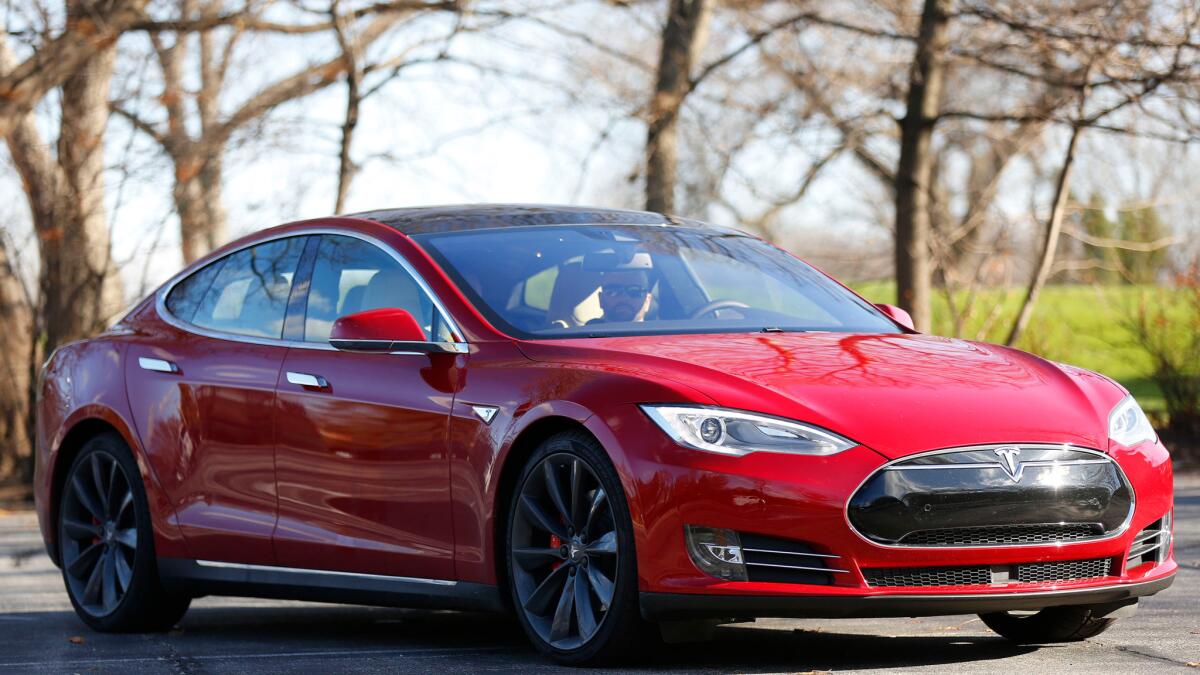Controversy over Tesla ‘autopilot’ name keeps growing

Reporting from San Francisco — What’s in a name? For Tesla’s driver-assist system “autopilot,” plenty of controversy.
Some of the most enthusiastic proponents of autonomous vehicles and features are worried that autopilot — not the technology itself, but the very name, which some find misleading — might slow down the evolution of the driverless car. They say that would be a shame, as autonomous technologies are designed to make driving safer by preventing minor fender-benders as well as reducing the number of traffic fatalities.
A May 7 crash involving a Model S being driven in autopilot mode is all the buzz at the Automated Vehicle Symposium here this week, a major annual event for engineers, auto executives, software developers, policymakers and others involved in the transition of automobiles into robots. Most years, technology dominates the conference. This year, it’s safety and consumer readiness for robots that take over the driving.
Bob Youssef, senior manager for autonomous vehicle research at automotive parts supplier Hyundai Mobis, told a gathering of safety-minded colleagues that he’s worried about calls by Consumer Reports magazine and others to take autopilot off the road, at least temporarily, after a recent spate of car crashes involving Tesla vehicles. The automaker has emphasized that the technology is still in public beta mode.
Taking products off the market once they’re on the roads, Youssef fears, will “kill the technology before it’s even started.”
His solution? “Change the name. Don’t call it autopilot.”
Standing nearby in the small crowd at the Hilton in Union Square was Lutz Eckstein of Germany’s Institute for Automotive Engineering.
“It appears Tesla doesn’t have a technical problem,” he said. “It’s a problem of creating customer expectations that can’t be fulfilled.”
“It’s a marketing problem,” someone else shouted, eliciting a general nodding of heads.
Tesla Chief Executive Elon Musk told the Wall Street Journal last week that he has no plans to change the name.
On Wednesday evening, Musk released the second part of his “master plan” for Tesla, which included a section about improving Tesla’s self-driving capability via massive fleet learning.
Autopilot, Must wrote “gets better every day. It would no more make sense to disable Tesla’s Autopilot, as some have called for, than it would [be] to disable autopilot in aircraft.”
Autopilot is the most advanced driver-assist technology on the road today. It steers, it changes lanes, it adjusts speed in response to traffic, it brakes for obstacles.
It didn’t brake, though, for Joshua Brown, when an 18-wheeler made a left-hand turn on a divided highway in Florida in front of Brown’s Tesla Model S, traveling on autopilot at about 65 mph, according to a police report. The car drove under the the truck’s trailer, the bottom edge of which sheared through the car at windshield level. After passing under the truck, the Tesla ran off the highway and eventually came to a stop. Brown, 40, was killed.
“Neither autopilot nor the driver noticed the white side of the tractor trailer against the brightly lit sky, so the brake was not applied,” Tesla has said in a blog post. Because of the trailer’s “high ride height,” autopilot drove under the truck instead of noticing an obstruction and stopping, the post said, calling it a “rare” circumstance and indicating that autopilot software would be updated as experience accumulates.
Supporters of the autonomous cars say the Florida crash overshadowed safety gains. The company spotlighted crash statistics: For vehicles in the U.S., there is a fatality every 94 million miles, while the Florida crash was the first known Tesla fatality in over 130 million miles in which autopilot was activated. And Tesla pointed out that it makes clear that drivers are supposed to keep alert, with hands on the steering wheel at all times, whether autopilot is turned on or not.
Valerie Shuman, a new-products consultant and vice president for the Connected Vehicle Trade Assn., said expecting drivers to turn over driving duties to an automated system but still be ready to react in two to three seconds is unrealistic. “Consumers don’t work like that,” she said.
But the chatter at the conference was about customer perception and human-machine interaction, not crash numbers and instruction manuals.
The name autopilot lulls drivers into a false sense of complacency, said John M. Simpson at the advocacy group Consumer Watchdog.
“It creates confusion in the average person’s mind,” he said, “leading them to believe the vehicle is capable of more than it is.”
YouTube videos that show Tesla drivers apparently sleeping at the wheel or climbing into the back seat make that clear, Simpson said.
Autopilot is the term used for aviation electronics that allow a trained pilot and an automatic system to share duties flying a plane, and it’s got a cool, high-tech connotation.
“People familiar with the operation of aviation systems know that,” Geoffrey Nunberg, a linguist at UC Berkeley and contributor to the radio show “Fresh Air,” said in a telephone interview. But not the average person. To the public at large, he said, “autopilot refers to a state when you’re not applying thought, concentration and effort to what you’re doing.”
Technologies often go through a series of name changes before finding one that sticks. In 1958, for example, Chrysler called its new cruise-control system “Auto-Pilot”.
Simpson suggested Tesla change the name to “Driver Assist” or “Co-Pilot.”
Can you think of a better name? If so, let us know in the comments section below.
ALSO
Day 3 of the Republican convention sparks a renewed war over conservatism
Intersex person who was denied a passport over gender designation sues U.S. government
Billion Dollar Shave Club: L.A. start-up is purchased by Unilever for a staggering sum




